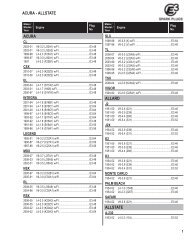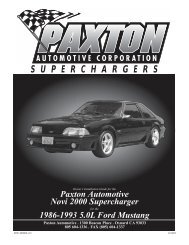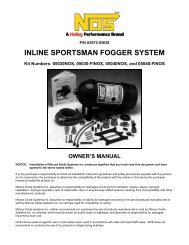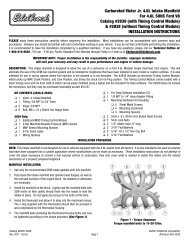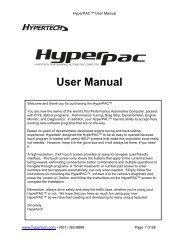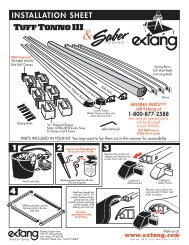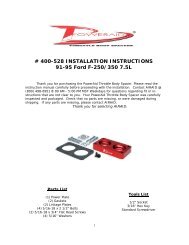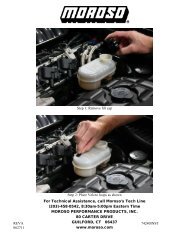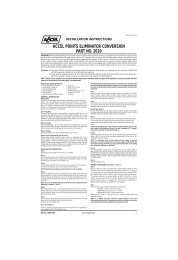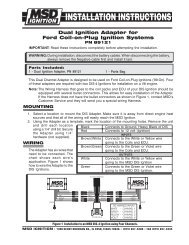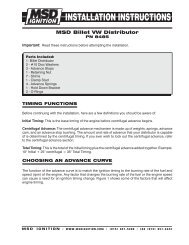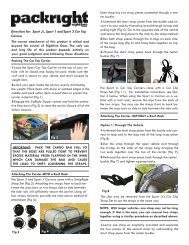Edelbrock 70055 Nitrous System Installation Instructions - Jegs
Edelbrock 70055 Nitrous System Installation Instructions - Jegs
Edelbrock 70055 Nitrous System Installation Instructions - Jegs
Create successful ePaper yourself
Turn your PDF publications into a flip-book with our unique Google optimized e-Paper software.
5.0 Ignition Timing and <strong>Nitrous</strong><br />
Because we are oxidizing the air/fuel mix going into the engine when nitrous oxide is used, we must pay close<br />
attention to the ignition timing profile. Remember, “nitrous” oxygen is more dense than “atmospheric” oxygen and<br />
results in an accelerated burn rate of your fuel.<br />
In anticipation of the quicker burn time, you must retard the timing of the ignition system when using nitrous oxide.<br />
The more power we try to make, the more timing in degrees we must remove from the timing profile. This is not<br />
only in total advance but the time in which we bring timing in (the advance curve).<br />
This is why all nitrous users are so concerned with evidence of detonation. The accelerated burn rate of the air/fuel<br />
charge can cause severe detonation without a “nitrous” ignition strategy. A timing profile that is accelerated and a<br />
total timing number retarded will keep you from experiencing catastrophic engine damage.<br />
The general rule of nitrous use ignition timing should be to retard the “Total” advance number approximately 2<br />
degrees for every 50 HP increase when using nitrous oxide. It is always best to start with your engines best total<br />
timing (without nitrous) and reduce total timing from there. Use an initial timing retard setting that is at least 2-4<br />
degrees more retarded than you expect to be the best setting for your application. All stated timing adjustments<br />
listed in jet maps is where the motor being tested worked best.<br />
When using aftermarket ignition components and/or systems, it would be advisable to contact the manufacturer for<br />
information on using their components with a nitrous system. It is always better to be very conservative in your<br />
timing approach and tune towards an optimum timing setting.<br />
Example:<br />
Ignition timing without <strong>Nitrous</strong> Oxide<br />
38 degrees “total”<br />
100 HP increase from <strong>Nitrous</strong> Oxide 4 degrees “retard”<br />
Initial safety margin<br />
2 degrees “retard”<br />
Initial timing with <strong>Nitrous</strong> Oxide<br />
32 degrees “total”<br />
The following test plan, for determining ignition timing, will give you a guide to determine the best timing profile for<br />
your vehicle, hopefully avoiding engine damage during the tuning phase:<br />
Install the nitrous jetting for a selected horsepower increase. Use the 100 horsepower setting to learn the finer<br />
points of working with nitrous oxide. This will keep your margin for error as large as possible. Estimate the reduced<br />
ignition timing that you think will produce best power, based upon the 2-degree retard per 50 horsepower increase<br />
rule.<br />
1. Set ignition timing 2-3 degrees retarded from your best power estimate setting. This is your cushion for<br />
error.<br />
2. Stabilize nitrous bottle pressure at 900 to 950 psi. It is best to select a pressure and keep the pressure to<br />
+/- 25 psi.<br />
3. Run your vehicle in a controlled manner (like a ¼ mile drag strip) without the use of nitrous. This is called<br />
“on motor”. Note vehicle mph as a baseline to measure nitrous assisted increases. Adjust your ignition<br />
timing to a nitrous timing setting.<br />
4. Run your vehicle in the same controlled manner (like a ¼ mile drag strip) with the use of nitrous. Note<br />
vehicle mph increase and compare it to your baseline.<br />
Note: Listen for any knocking sounds when running the vehicle. Watch your temperature gauges.<br />
Continued nitrous use will elevate coolant temperatures. See Testing Checklist for more testing<br />
methodology helpful hints.<br />
Catalog #<strong>70055</strong> & #70056<br />
Brochure No. 63-0060<br />
Page 22 of 26<br />
©2002 <strong>Edelbrock</strong> Corporation<br />
Rev. 3/02



